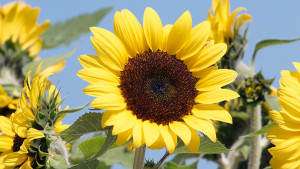 In 1928, a year before the onset of the Great Depression, the Carter Family, of folk and country music fame, recorded a song, “Keep on the Sunny Side”, that was originally written as a hymn. It became one of their standards and has lifted spirits ever since. The refrain is as follows:
In 1928, a year before the onset of the Great Depression, the Carter Family, of folk and country music fame, recorded a song, “Keep on the Sunny Side”, that was originally written as a hymn. It became one of their standards and has lifted spirits ever since. The refrain is as follows:
Keep on the sunny side, always on the sunny side
Keep on the sunny side of life
It will help us every day, it will brighten all the way
If we’ll keep on the sunny side of life
Now, as the coronavirus takes its toll, those lyrics have renewed resonance. I have decided to “keep on the sunny side” by considering the plant with “sun” in its Latin and common names, Helianthus anuus, better known as annual sunflower.
Beneath their gargantuan stalks and showy flowerheads, annual sunflowers are all daisies at heart. This means they are members of the great Compositae–formerly Asteraceae–family. Like other daisies, annual sunflowers sport long, petal-like rays in colors including cream; a range of yellows, gold to golden orange; peach; red; and burgundy. Breeders have created amazing bi-colored sunflowers as well. As with other daisies, the tiny true flowers are in the plants’ centers, which may be black, brown or even greenish. Bees make beelines to those centers, as do other pollinators. When the seeds ripen, they attract birds. Raised commercially, annual sunflowers are also the source of the tasty seeds that we buy at supermarkets and convenience stores.
People in many cultures and countries have taken cheerful sunflowers to their hearts.
Artist Vincent Van Gogh painted them in France in the 1880’s, but their story began in North America, where they are native to the western parts of Canada and the United States, as well as northern Mexico. Tough and drought tolerant, native sunflowers frequent plains, prairies, and other open, sunny spaces. Today their cultivated and hybridized relatives adorn gardens all over the world.
Many of us remember planting oversized sunflower seeds in paper cups as children. They sprout quickly, providing maximum gratification no matter how old you are. In fact, the plants grow so fast that you can direct-sow them in the ground as soon as all danger of frost has passed. In my part of the world, the last frost date is around April 15, which is when I will sow my seeds.
The range of choices is large. If you are longing for a really big, traditional sunflower, choose the classic ‘Mammoth’, which soars up to 12 feet tall, with huge flower heads and golden petals. ‘Arikara’, grown by Native Americans, is another tall grower and features vivid golden-orange petals surrounding seed-packed centers.
Some gardeners prefer sunflowers that are a little less brassy. If you are one of them, choose a variety like ‘Italian White’, which tops out at five feet, and produces cream to pale yellow flowers around brown centers. ‘Procut White Nite’ is another pale variety, growing up to six feet tall with vivid black centers.
If red to reddish bronze flowers are your cup of tea, you will glory in ‘Claret’, featuring colors reminiscent—at least in some soils and situations—of claret wine. ‘Claret’ grows five to six feet tall. Slightly shorter, at up to five feet tall, is the racy ‘Red Courtesan’, with dark red petals and deep black centers.
Some of us will always need something just a little over the top. If that is your cup of sunflower tea, choose ‘Big Bear’, with a fluffy, many-petaled flowerhead that looks more like a mum than a sunflower. It grows to about six feet tall with a branching habit. If “over the top” means eye-catching colors, you may be drawn to varieties like ‘Ring of Fire’, a five-footer with a black center ringed with petals that are red at the base and gold at the tips. ‘Shock-o-Lat’ is a similar bi-color with chocolate-brown centers and burgundy petals with gold tips.
Container gardeners need not forsake the charms of sunflowers. Growing three to five feet tall, ‘Teddy Bear” sports shaggy, multi-petaled flowers with green centers. “Sunny Smile” is a true miniature, reaching less than two feet tall at maturity, and featuring traditional golden yellow blooms that grow up to five inches across. Flashy little ‘Firecracker’ tops out at three feet tall, with big, dark centers and red petals bordered in yellow.
Flower arrangers love sunflowers because they have a big impact in arrangements and last a long time. Grow plenty so that you will have enough for you, the pollinating insects and the birds.
True to their name, sunflowers like sunny situations. The tall types work best at the backs of traditional beds, or the centers of round planting areas. Staking may be required, although the traditional varieties tend to have very thick stalks. The leaves may degrade as the growing season goes on. If their tattered looks bother you, simply clip them off.
Find sunflower seed packets in nurseries, garden centers and other retail outlets. For a good online assortment, try Select Seeds, 180 Stickney Hill Road, Union, CT, 06076; (800) 684-0395; www.selectseeds.com. Free print catalog.
